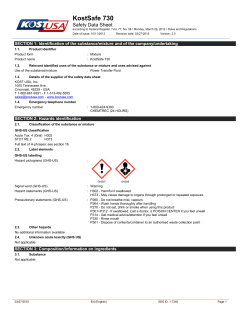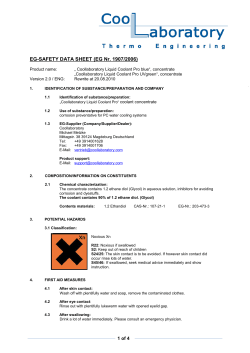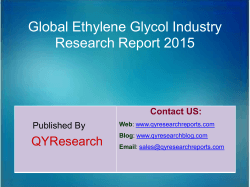
1-7218
Triethylene Glycol Safety Data Sheet according to Federal Register / Vol. 77, No. 58 / Monday, March 26, 2012 / Rules and Regulations Date of issue: 12/17/2012 Revision date: 03/20/2015 Supersedes: 11/20/2014 Version: 2.0 SECTION 1: Identification of the substance/mixture and of the company/undertaking 1.1. Product identifier Product form : Substance Substance name : Triethylene Glycol Chemical name : 2-(2-(2-Hydroxyethoxy)ethoxy)ethanol CAS No : 112-27-6 Formula : C6H14O4 Synonyms : Triethylene Glycol, GT Other means of identification : TEG Triglycol 2,2'-(ethylenedioxy)diethanol 1.2. Relevant identified uses of the substance or mixture and uses advised against Use of the substance/mixture 1.3. : Intermediate Details of the supplier of the safety data sheet KOST USA, Inc. 1000 Tennessee Ave. Cincinnati, 45229 - USA T 1-800-661-9391 - F 1-513-492-5555 sales@kostusa.com - www.kostusa.com 1.4. Emergency telephone number Emergency number : 1-800-424-9300 CHEMTREC (24 HOURS) SECTION 2: Hazards identification 2.1. Classification of the substance or mixture GHS-US classification STOT RE 2 H373 Full text of H-phrases: see section 16 2.2. Label elements GHS-US labelling Hazard pictograms (GHS-US) : Signal word (GHS-US) : Warning Hazard statements (GHS-US) : H373 - May cause damage to organs through prolonged or repeated exposure Precautionary statements (GHS-US) : P260 - Do not breathe mist, vapours P314 - Get medical advice/attention if you feel unwell P501 - Dispose of contents/container to an authorised waste collection point GHS08 2.3. Other hazards No additional information available 2.4. Unknown acute toxicity (GHS US) Not applicable SECTION 3: Composition/information on ingredients 3.1. Substance Name : Triethylene Glycol CAS No : 112-27-6 03/20/2015 EN (English) SDS ID: 1-7208 Page 1 Triethylene Glycol Safety Data Sheet according to Federal Register / Vol. 77, No. 58 / Monday, March 26, 2012 / Rules and Regulations Name Product identifier % GHS-US classification Diethylene glycol (CAS No) 111-46-6 <= 5 Acute Tox. 4 (Oral), H302 STOT RE 2, H373 Ethylene glycol (CAS No) 107-21-1 0-1 Acute Tox. 4 (Oral), H302 STOT RE 2, H373 Full text of H-phrases: see section 16 3.2. Mixture Not applicable 4.1. Description of first aid measures First-aid measures general : Never give anything by mouth to an unconscious person. If you feel unwell, seek medical advice (show the label where possible). First-aid measures after inhalation : If inhaled and if breathing is difficult, remove victim to fresh air and keep at rest in a position comfortable for breathing. First-aid measures after skin contact : Wash with plenty of soap and water. First-aid measures after eye contact : If in eyes: Rinse cautiously with water for several minutes. Remove contact lenses, if present and easy to do. Continue rinsing. First-aid measures after ingestion : Do NOT induce vomiting. Rinse mouth. Get immediate medical advice/attention. 4.2. Most important symptoms and effects, both acute and delayed Symptoms/injuries : Causes damage to organs (kidney, renal, respiratory, CNS) through prolonged or repeated exposure (oral). Symptoms/injuries after inhalation : In high concentrations : Inhalation may cause: irritation, coughing, shortness of breath. Symptoms/injuries after skin contact : May cause moderate irritation. Symptoms/injuries after eye contact : Direct contact with the eyes is likely to be irritating. Symptoms/injuries after ingestion : Like any product not designed to be ingested, this product may cause stomach distress if ingested in large quantities. 4.3. Indication of any immediate medical attention and special treatment needed All treatments should be based on observed signs and symptoms of distress in the patient. SECTION 5: Firefighting measures 5.1. Extinguishing media Suitable extinguishing media : Carbon dioxide. Dry powder. Foam. Sand. Unsuitable extinguishing media : Do not use a heavy water stream. 5.2. Special hazards arising from the substance or mixture Fire hazard : No particular fire or explosion hazard. Reactivity : No dangerous reactions known. 5.3. Advice for firefighters Firefighting instructions : Cool adjacent structures and containers with water spray to protect and prevent ignition. Exercise caution when fighting any chemical fire. Do not allow run-off from fire fighting to enter drains or water courses. Protection during firefighting : Do not enter fire area without proper protective equipment, including respiratory protection. Use self-contained breathing apparatus. Wear fire/flame resistant/retardant clothing. SECTION 6: Accidental release measures 6.1. Personal precautions, protective equipment and emergency procedures General measures 6.1.1. For non-emergency personnel Emergency procedures 6.1.2. : Evacuate unnecessary personnel. For emergency responders Emergency procedures 6.2. : Avoid all eye and skin contact and do not breathe vapour and mist. : Ventilate area. Environmental precautions Do not discharge into drains or the environment. Prevent entry to sewers and public waters. 6.3. Methods and material for containment and cleaning up For containment 03/20/2015 : Contain any spills with dikes or absorbents to prevent migration and entry into sewers or streams. Absorb and/or contain spill with inert material, then place in suitable container. EN (English) SDS ID: 1-7208 2/1 Triethylene Glycol Safety Data Sheet according to Federal Register / Vol. 77, No. 58 / Monday, March 26, 2012 / Rules and Regulations Methods for cleaning up 6.4. : Take up in non-combustible absorbent material and shove into container for disposal. Reference to other sections Section 13: disposal information. Section 7: safe handling. Section 8: personal protective equipment. SECTION 7: Handling and storage 7.1. Precautions for safe handling Precautions for safe handling : Avoid breathing vapours. Do not get in eyes, on skin, or on clothing. Hygiene measures : Wash hands and other exposed areas with mild soap and water before eating, drinking or smoking and when leaving work. 7.2. Conditions for safe storage, including any incompatibilities Storage conditions : Do not store near food, foodstuffs, drugs, or potable water supplies. Store in a dry, cool and well-ventilated place. Incompatible products : Strong oxidizers. Strong bases. Strong acids. Incompatible materials : Heat sources. Sources of ignition. 7.3. Specific end use(s) Intermediate. SECTION 8: Exposure controls/personal protection 8.1. Control parameters Diethylene glycol (111-46-6) ACGIH Not applicable OSHA Not applicable Ethylene glycol (107-21-1) ACGIH ACGIH Ceiling (mg/m³) 100 mg/m³ ACGIH ACGIH Ceiling (ppm) 39.4 ppm ACGIH Remark (ACGIH) URT & eye irr OSHA Not applicable 8.2. Exposure controls Appropriate engineering controls : Avoid creating mist or spray. Avoid splashing. Provide local exhaust ventilation of closed transfer systems to minimize exposures. Personal protective equipment : Avoid all unnecessary exposure. Hand protection : Wear suitable gloves resistant to chemical penetration. Eye protection : Chemical goggles or safety glasses. Respiratory protection : In case of inadequate ventilation wear respiratory protection. Use air-purifying respirator equipped with particulate filtering cartridges. Other information : Do not eat, drink or smoke when using this product. SECTION 9: Physical and chemical properties 9.1. Information on basic physical and chemical properties Physical state : Liquid Appearance : Free & clear. Colour : Colourless Odour : odourless Odour threshold : No data available pH : 8 (estimate) Relative evaporation rate (butyl acetate=1) : No data available Melting/Freezing point : -7 °C Boiling point : > 280 °C Flash point : 171 °C (PMCC) Auto-ignition temperature : 323 °C Decomposition temperature : No data available Flammability (solid, gas) : No data available Vapour pressure : < 0.01 mm Hg @ 20 °C 03/20/2015 EN (English) SDS ID: 1-7208 3/1 Triethylene Glycol Safety Data Sheet according to Federal Register / Vol. 77, No. 58 / Monday, March 26, 2012 / Rules and Regulations Relative vapour density at 20 °C : No data available Relative density : 1.12 - 1.13 Solubility : Soluble in water Log Pow : No data available Viscosity : No data available Explosive limits : 0.9 - 9.2 vol % 9.2. Other information No additional information available SECTION 10: Stability and reactivity 10.1. Reactivity No dangerous reactions known. 10.2. Chemical stability Stable at ambient temperature and under normal conditions of use. 10.3. Possibility of hazardous reactions Hazardous polymerization will not occur. 10.4. Conditions to avoid Sparks. Keep away from sources of ignition. Heat. 10.5. Incompatible materials Strong acids. Strong bases. Strong oxidizing agents. 10.6. Hazardous decomposition products Carbon dioxide. Carbon monoxide. Aldehydes. SECTION 11: Toxicological information 11.1. Information on toxicological effects Acute toxicity : Not classified Triethylene Glycol (112-27-6) LD50 oral rat LD50 dermal rabbit LC50 inhalation rat (mg/l) > 2000 mg/kg > 2000 mg/kg > 4.95 mg/l/4h Diethylene glycol (111-46-6) LD50 dermal rat LC50 inhalation rat (mg/l) ATE US (oral) ATE US (dermal) 13300 mg/kg > 4.6 mg/l/4h 500.000 mg/kg bodyweight 13300.000 mg/kg bodyweight Ethylene glycol (107-21-1) LD50 oral rat LD50 dermal rat LC50 inhalation rat (mg/l) ATE US (oral) 7712 mg/kg > 3500 mg/kg mouse > 2.5 mg/l/4h 500.000 mg/kg bodyweight Skin corrosion/irritation : Not classified Serious eye damage/irritation : Not classified Respiratory or skin sensitisation : Not classified Germ cell mutagenicity : Not classified Carcinogenicity : Not classified Reproductive toxicity : Not classified Specific target organ toxicity (single exposure) : Not classified Specific target organ toxicity (repeated exposure) : May cause damage to organs through prolonged or repeated exposure. Ethylene glycol (107-21-1) NOAEL (oral, rat, 90 days) 150 mg/kg bodyweight/day kidney Aspiration hazard : Not classified Symptoms/injuries after inhalation : In high concentrations : Inhalation may cause: irritation, coughing, shortness of breath. 03/20/2015 EN (English) SDS ID: 1-7208 4/1 Triethylene Glycol Safety Data Sheet according to Federal Register / Vol. 77, No. 58 / Monday, March 26, 2012 / Rules and Regulations Symptoms/injuries after skin contact : May cause moderate irritation. Symptoms/injuries after eye contact : Direct contact with the eyes is likely to be irritating. Symptoms/injuries after ingestion : Like any product not designed to be ingested, this product may cause stomach distress if ingested in large quantities. Likely routes of exposure : Ingestion;Skin and eye contact SECTION 12: Ecological information 12.1. Toxicity Triethylene Glycol (112-27-6) LC50 fish 1 LC50 other aquatic organisms 1 EC50 Daphnia 1 > 1000 mg/l > 1000 mg/l > 1000 mg/l Diethylene glycol (111-46-6) LC50 fish 1 EC50 Daphnia 1 75200 mg/l > 10000 mg/l Ethylene glycol (107-21-1) LC50 fish 1 EC50 Daphnia 1 NOEC chronic fish NOEC chronic crustacea 72860 mg/l Pimephales promelas > 100 mg/l 15380 mg/l Pimephales promelas 8590 mg/l Ceriodaphnia sp. 12.2. Persistence and degradability Triethylene Glycol (112-27-6) Persistence and degradability inherently biodegradable. Diethylene glycol (111-46-6) Persistence and degradability Readily biodegradable. Ethylene glycol (107-21-1) Persistence and degradability Readily biodegradable. 12.3. Bioaccumulative potential Triethylene Glycol (112-27-6) Bioaccumulative potential Does not biaccumulate significantly. Diethylene glycol (111-46-6) Bioconcentration factor (BCF REACH) Log Pow Bioaccumulative potential 100 -1.98 Not expected to bioaccumulate. Ethylene glycol (107-21-1) Log Pow Bioaccumulative potential - 1.36 Not expected to bioaccumulate. 12.4. Mobility in soil Triethylene Glycol (112-27-6) Ecology - soil 12.5. Dissolves in water. If products enter soil, will be highly mobile and may contaminate ground water. Other adverse effects No additional information available SECTION 13: Disposal considerations 13.1. Waste treatment methods Sewage disposal recommendations : Do not dispose of waste into sewer. Waste disposal recommendations : Dispose in a safe manner in accordance with local/national regulations. SECTION 14: Transport information In accordance with DOT Not considered a dangerous good for transport regulations 03/20/2015 EN (English) SDS ID: 1-7208 5/1 Triethylene Glycol Safety Data Sheet according to Federal Register / Vol. 77, No. 58 / Monday, March 26, 2012 / Rules and Regulations Additional information Other information : No supplementary information available. ADR No additional information available Transport by sea No additional information available Air transport No additional information available SECTION 15: Regulatory information 15.1. US Federal regulations Diethylene glycol (111-46-6) Listed on the United States TSCA (Toxic Substances Control Act) inventory Ethylene glycol (107-21-1) Listed on the United States TSCA (Toxic Substances Control Act) inventory EPA TSCA Regulatory Flag T - T - indicates a substance that is the subject of a Section 4 test rule under TSCA. RQ (Reportable quantity, section 304 of EPA's 5000 lb List of Lists) SARA Section 313 - Emission Reporting >95% 15.2. International regulations CANADA Diethylene glycol (111-46-6) Listed on the Canadian DSL (Domestic Substances List) inventory. Ethylene glycol (107-21-1) Listed on the Canadian DSL (Domestic Substances List) inventory. EU-Regulations Diethylene glycol (111-46-6) Listed on the EEC inventory EINECS (European Inventory of Existing Commercial Chemical Substances) Ethylene glycol (107-21-1) Listed on the EEC inventory EINECS (European Inventory of Existing Commercial Chemical Substances) Classification according to Regulation (EC) No. 1272/2008 [CLP] Not classified Classification according to Directive 67/548/EEC [DSD] or 1999/45/EC [DPD] Not classified 15.2.2. National regulations Diethylene glycol (111-46-6) Listed on the Japanese ENCS (Existing & New Chemical Substances) inventory Listed on the AICS (Australian Inventory of Chemical Substances) Listed on Taiwan National Chemical Inventory Listed on NZIoC (New Zealand Inventory of Chemicals) Listed on KECI (Korean Existing Chemicals Inventory) Listed on IECSC (Inventory of Existing Chemical Substances Produced or Imported in China) Listed on PICCS (Philippines Inventory of Chemicals and Chemical Substances) \ Ethylene glycol (107-21-1) Listed on the Japanese ENCS (Existing & New Chemical Substances) inventory Listed on the AICS (Australian Inventory of Chemical Substances) Listed on Taiwan National Chemical Inventory Listed on NZIoC (New Zealand Inventory of Chemicals) Listed on KECI (Korean Existing Chemicals Inventory) Listed on IECSC (Inventory of Existing Chemical Substances Produced or Imported in China) Listed on PICCS (Philippines Inventory of Chemicals and Chemical Substances) \ 03/20/2015 EN (English) SDS ID: 1-7208 6/1 Triethylene Glycol Safety Data Sheet according to Federal Register / Vol. 77, No. 58 / Monday, March 26, 2012 / Rules and Regulations 15.3. US State regulations Ethylene glycol (107-21-1) U.S. - Minnesota - Hazardous Substance List U.S. - Pennsylvania - List of Hazardous Substances U.S. - New Jersey - Right to Know Hazardous Substance List SECTION 16: Other information Disclaimer: Although reasonable care has been taken in the preparation of this document, we extend no warranties and make no representations as to the accuracy or completeness of the information contained herein, and assume no responsibility regarding the suitability of this information for the user's intended purposes or for the consequences of its use. Each individual should make a determination as to the suitability of the information for their particular purpose(s). End-use applications NOT supported by Kost USA, Inc. for monoethylene glycol, diethylene glycol and triethylene glycol. These limitations include products restricted by law, applications in which may raise unacceptable risks, and other applications which Kost USA, Inc. has decided not to, including minimizing unnecessary risk and liabilities to the company. Kost USA, Inc. does not knowingly market these products into these non-supported applications. This list is not all-inclusive, and Kost USA, Inc. reserves the right to modify the same at any time. The use of production of tobacco and in the manufacture of tobacco products (including but not limited to additives, humectants, filters, inks, and paper) The use for the generation of artificial smoke / theatrical fogs / mist. This includes applications such as artificial / e-cigarettes. The use as ingredient in fuel for warming foods (Sterno™-like application) or in fuel for heating an enclosed space where human exposure is possible. The use in fire extinguishing sprinkler systems. The use in the manufacture of munitions. The use in the production of de-icers for use on roadways, sidewalks and in aircraft lavatories. The use as a component of heat transfer fluids in systems where the heat transfer fluids could infiltrate (i.e., via an exchanger leak, backflow prevention failure, or other means) a potable water. The use as a non-reacted component in a formulation for direct internal or external human / animal contact, including, but not limited to ingestion, inhalation, and skin contact and in medical / veterinary devices and medial / veterinary. Examples of some such applications are uses as a direct component in foods, beverages, pharmaceuticals, cosmetics, personal care products or children's products. The use for consumer or hospital usage for deodorizing or air "purifying" purposes by spraying as an aerosol. The use as a non-reacted component in adhesives, plasticizers, and softening agents for packaging having direct contact with food or beverage. The use as a non-reacted component in the formulation of glues, pastes, ice / heat packs or other items where the potential for significant human contact and/or ingestion exists (including but not limited to children's school glue/paste or arts/craft glue/paste, toys, children products). The use as a fluid for pressure testing piping. For more information contact your Kost USA, Inc. representative. Indication of changes : Composition update. Revision date : 03/20/2015 Data sources : ESIS (European chemincal Substances Information System; accessed at: http://esis.jrc.ec.europa.eu/index.php?PGM=cla. ACGIH 2000. European Chemicals Agency (ECHA) Registered Substances list. Accessed at http://echa.europa.eu/. Krister Forsberg and S.Z. Mansdorf, "Quick Selection Guide to Chemical Protective Clothing", Fifth Edition. National Fire Protection Association; Fire Protection Guide to Hazardous Materials; 10th edition. OSHA 29CFR 1910.1200 Hazard Communication Standard. TSCA Chemical Substance Inventory. Accessed at http://www.epa.gov/oppt/existingchemicals/pubs/tscainventory/howto.html. 03/20/2015 EN (English) SDS ID: 1-7208 7/1 Triethylene Glycol Safety Data Sheet according to Federal Register / Vol. 77, No. 58 / Monday, March 26, 2012 / Rules and Regulations Abbreviations and acronyms : ACGIH (American Conference of Governement Industrial Hygienists). ATE: Acute Toxicity Estimate. CAS (Chemical Abstracts Service) number. CLP: Classification, Labelling, Packaging. EC50: Environmental Concentration associated with a response by 50% of the test population. GHS: Globally Harmonized System (of Classification and Labeling of Chemicals). LD50: Lethal Dose for 50% of the test population. OSHA: Occupational Safety & Health Administration. STEL: Short Term Exposure Limits. TSCA: Toxic Substances Control Act. TWA: Time Weight Average. Other information Full text of H-phrases: -----Acute Tox. 4 (Oral) -----STOT RE 2 -----H302 -----H373 : None. Acute toxicity (oral), Category 4 Specific target organ toxicity — Repeated exposure, Category 2 Harmful if swallowed May cause damage to organs through prolonged or repeated exposure NFPA health hazard : 1 - Exposure could cause irritation but only minor residual injury even if no treatment is given. NFPA fire hazard : 1 - Must be preheated before ignition can occur. NFPA reactivity : 0 - Normally stable, even under fire exposure conditions, and not reactive with water. SDS Prepared by: The Redstone Group, LLC 6397 Emerald Pkwy. Suite 200 Dublin, OH USA 43016 T 614-923-7472 www.redstonegrp.com 03/20/2015 EN (English) SDS ID: 1-7208 8/1
© Copyright 2025









